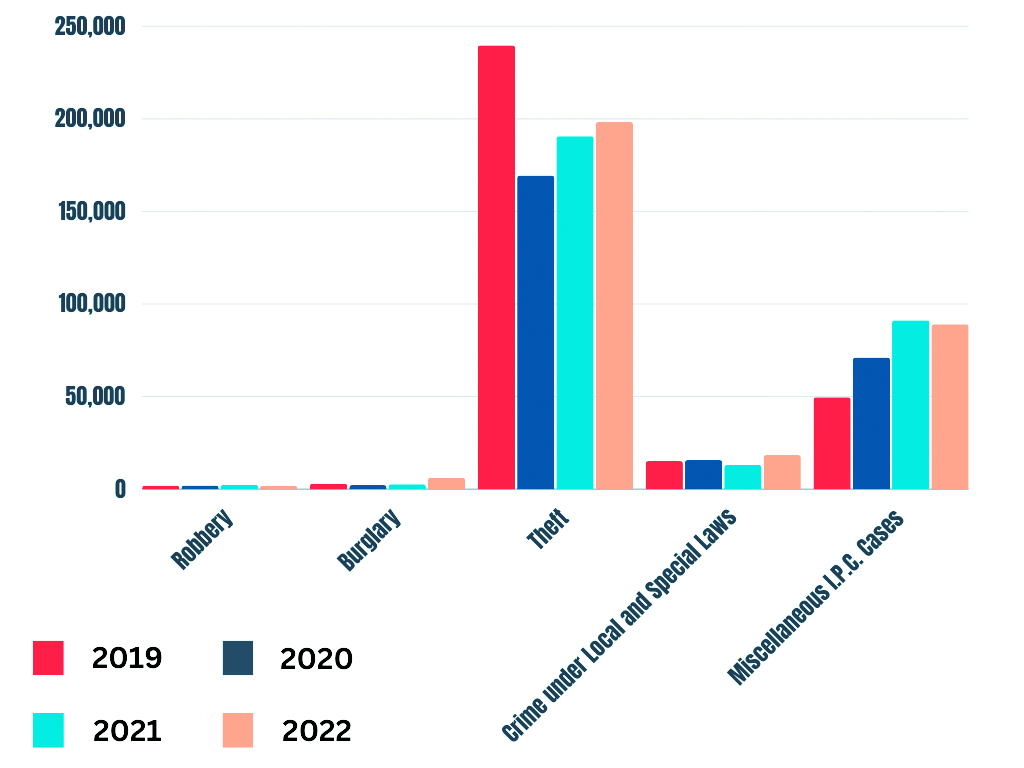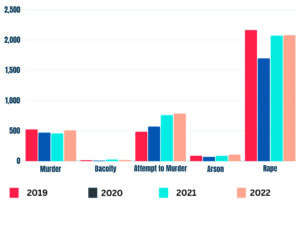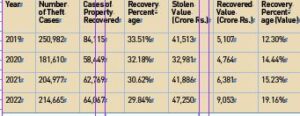

The comprehensive analysis of crime data, as documented in the Delhi Statistical Handbook-2023, offers a detailed perspective on the evolving landscape of criminal activities and law enforcement efforts in the national capital. Focusing on property-related offences, particularly theft cases, the report spans a four-year period from 2019 to 2022, revealing notable fluctuations in the occurrence of such incidents. Concurrently, the document delves into the effectiveness of law enforcement in recovering stolen property and the corresponding monetary value.
The Delhi Statistical Handbook-2023, a comprehensive compilation of socio-economic data pertaining to the national capital, has been officially released by the Economic and Statistics Department of the Delhi government.
According to the handbook’s findings, there was a discernible increase of 4.02 per cent in reported theft cases during the 2022-23 period when compared to the data from the preceding year, 2021-22. This statistical revelation sheds light on the evolving socio-economic landscape, underscoring the need for a nuanced understanding of the factors influencing crime rates in the dynamic context of the national capital.
In the statistical panorama revealed by the Delhi Statistical Handbook-2023, an uptick in criminal incidents is evident, particularly in the domain of attempted murder cases. The data illustrates a rise from 761 reported cases in 2021-22 to 785 cases in 2022-23, shedding light on the evolving crime landscape.
Additionally, the report highlights a concerning trend in theft cases, with over 500 incidents reported daily in the national capital during the fiscal year 2022-23, as per the official documentation from the city government’s Economic and Statistics department.
This comprehensive release provides a crucial insight into the socio-economic parameters of Delhi, offering a basis for further analysis and policy considerations to address the emerging challenges in the realm of public safety.
CASES OF THEFT, BURGLARY, ARSON, ROBBERY AND DACOITY
As outlined in the handbook, there was an observable increase of 4.02 per cent in theft cases during the fiscal year 2022-23 in comparison to the preceding year, 2021-22.
According to the documented statistics, Delhi recorded 1,90,598 theft cases in the financial year 2021-22. This number saw a rise to 1,98,263 reported theft cases in the subsequent financial year, 2022-23.
The data underscores a notable uptick in incidents of theft, prompting a closer examination of the contributing factors and necessitating potential interventions to address and mitigate such occurrences in the national capital.
The statistical overview from the handbook reveals a substantial surge of 134 per cent in burglary cases, indicating a noteworthy increase in criminal incidents.
Specifically, there were 2,637 reported burglary cases during the fiscal year 2021-22, a number that escalated significantly to 6,189 cases in the subsequent financial year, 2022-23.
The data on incidents of dacoity and robbery over the years 2019 to 2022 reveals fluctuating trends in these criminal activities. In 2019, there were 15 reported cases of dacoity, which decreased to 9 in 2020, before witnessing a substantial increase to 26 in 2021, only to slightly decline to 18 in 2022.
On the other hand, robbery cases exhibited a more complex pattern. In 2019, there were 1,956 reported cases, with a marginal increase to 1,963 in 2020.
The year 2021 saw a notable rise in robbery cases, reaching 2,333, but in 2022, the numbers decreased to 1,808.
These statistics shed light on the dynamic nature of criminal activities, urging a comprehensive analysis of contributing factors and potential interventions to address the fluctuations in dacoity and robbery incidents over the specified time frame.
This considerable rise underscores the importance of understanding and addressing the factors contributing to the surge in burglaries for effective crime prevention strategies.
Additionally, the data highlights a marginal increase in arson cases, with 105 incidents reported in 2022-23 compared to 88 cases in 2021-22.
This nuanced information further contributes to a comprehensive understanding of the evolving crime landscape in the national capital, providing valuable insights for policymakers and law enforcement agencies to formulate targeted interventions and enhance public safety measures.
CASES OF MURDER AND ATTEMPT TO MURDER
The statistical data from the relevant period highlights a concerning uptick in murder cases, indicating an increase of over 10 per cent from 459 reported cases in 2021-22 to 509 cases in 2022-23.
This rise in homicide incidents calls for a closer examination of the contributing factors and underscores the importance of implementing effective measures to address and mitigate such occurrences in the national capital.
Furthermore, the data also reveals a 3.15 per cent increase in attempt-to-murder cases. Specifically, there were 761 reported cases in 2021-22, a number that marginally rose to 785 cases in the subsequent fiscal year, 2022-23.
Understanding the dynamics of attempted murder cases is crucial for law enforcement and policymakers to formulate targeted strategies aimed at preventing such incidents and ensuring public safety. This nuanced analysis of crime trends provides valuable insights for informed decision-making and proactive measures to address emerging challenges in the realm of criminal offences.
CASES OF PROPERTY THEFT
Over the four-year span from 2019 to 2022, there has been a discernible ebb and flow in the occurrence of property theft cases. Commencing at 250,982 reported instances in 2019, there was a notable decline to 181,610 in 2020, succeeded by an ensuing upswing to 204,977 in 2021 and a further ascent to 214,665 in 2022.
Despite the undulating trajectory in case numbers, there has been a gradual waning in the percentage of recovery, decreasing from 33.51% in 2019 to 29.84% in 2022. In the realm of tangible property recovery, the efforts of law enforcement manifested in the retrieval of 84,115 items in 2019, a subsequent reduction to 58,449 in 2020, a marginal upturn to 62,769 in 2021, and a culmination at 64,067 in 2022.
The percentage of cases recovered also mirrored this diminishing trend, descending from 32.18% in 2019 to 29.84% in 2022. Concurrently, the monetary value attributed to stolen property witnessed an incremental surge over the years, amounting to approximately Rs. 41,513 Crore in 2019, Rs. 32,981 Crore in 2020, Rs. 41,886 Crore in 2021, and peaking at Rs. 47,250 Crore in 2022.
The endeavours in property recovery, gauged in terms of monetary value, also witnessed improvement, with the approximate value of recovered property scaling up to Rs. 5,107 Crore in 2019, Rs. 4,764 Crore in 2020, Rs. 6,381 Crore in 2021, and surging to Rs. 9,053 Crore in 2022. Consequently, the percentage of value recovered exhibited an ascending trajectory, rising from 12.3% in 2019 to a commendable 19.16% in 2022.
In conclusion, the comprehensive insights gleaned from the Delhi Statistical Handbook-2023 provide a thorough examination of the crime landscape and socio-economic dynamics in the national capital. In essence, the comprehensive data presented in this analysis serves as a vital resource for policymakers, law enforcement agencies, and researchers in formulating evidence-based strategies to address emerging challenges and enhance public safety in Delhi.
